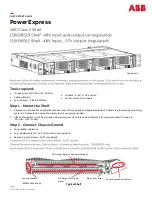
Breakers
Different regions of the world have different sizing requirements for branch circuit conductors and circuit breakers.
In Europe and other regions where IEC standards apply, circuits breakers generally are rated at 100% utilization,
meaning that a device connected to a dedicated branch circuit may draw a maximum current up to the circuit
breaker rating. In the United States, the NEC generally specifies what is known as the "80% rule" which requires
branch circuits to be rated at 1.25 times the maximum nameplate rating of the connected device.
Standard circuit breaker sizes also vary by region. The table below provides guidance for circuit breaker sizing for
various nominal mains voltages. The guidance for North American mains voltages (120, 208, and 240 V) includes
the 1.25 factor associated with the 80% rule. Guidance for the other voltages (100, 200, and 230 V) assumes 100%
utilization. By comparing the table above with the table below, it may be seen that for the AC6801A and AC6802A
models, the smallest standard size breaker affords more than enough capability to supply the device. The AC6803A
and AC6804A products drawn higher currents and therefore are more likely to require higher breaker current
ratings and dedicated circuits.
For convenience, notes below the table give standard breaker sizes per IEC/EN 60898-1 and the NEC for the United
States.
Consult with local authorities to ensure full compliance with electrical code and safety requirements before
connecting any AC6800 Series instrument.
Breaker Sizes
Line Voltage AC6801A AC6802A AC6803A AC6804A
100
15
20
35
70
120
15
20
40
70
200
15
15
20
35
208
15
15
20
40
230
16
16
16
32
240
15
15
20
40
IEC 60898-1 and European Standard EN 60898-1 Standard Sizes
6, 10, 13, 16, 20, 25, 32, 40, 50, 63, 80, and 100 A
NEMA Standard Sizes (also commonly used in Japan)
15, 20, 25, 30, 35, 40, 45, 50, 60, 70, 80, 90, and 100 A
30
Keysight AC6800 Series Operating and Service Guide











































